Mastering keyword research is one of the most crucial skills you need to succeed with content and online marketing. But with so many tools and strategies, where do you even start? Don’t worry, we’ve got you covered.
In this complete guide, we’ll walk through step-by-step how to leverage the power of Semrush for next-level keyword research. You’ll learn insider tips and tricks for discovering high-potential keywords, analyzing the competition, tracking search volume trends, and more.
So get ready to become a keyword research pro with Semrush!
Why Keyword Research Is Crucial for Content Marketing
Keywords are the foundation of any content marketing strategy. By researching what terms your target audience is searching for, you can create content that ranks well in search engines and drives qualified traffic to your site.
Reach More Potential Customers
The right keywords will help your content appear in search results for queries that relate to your products or services. This exposes you to new potential customers who are actively searching for solutions like yours.
Say you run a dog training business. If you target keywords like “puppy training” or “basic obedience training,” your content could show up when someone searches for those topics. That reader may then visit your site, connect with your brand, and become a customer.
Gain Valuable Insights
Keyword research also provides insights into your audience’s interests, questions, and pain points. By analyzing popular searches, you can determine what types of content and information your readers really want.
You may find that blog posts on house training a puppy or stopping excessive barking are in high demand. That tells you those subjects would make great content topics to better serve your audience.
In summary, keyword research is the compass that guides your content marketing strategy. It points you to topics and terms that will resonate with your readers, help search engines find and rank your content, and ultimately drive more quality traffic to your website. For any content creator, keyword research is time well spent.
Introduction to Semrush
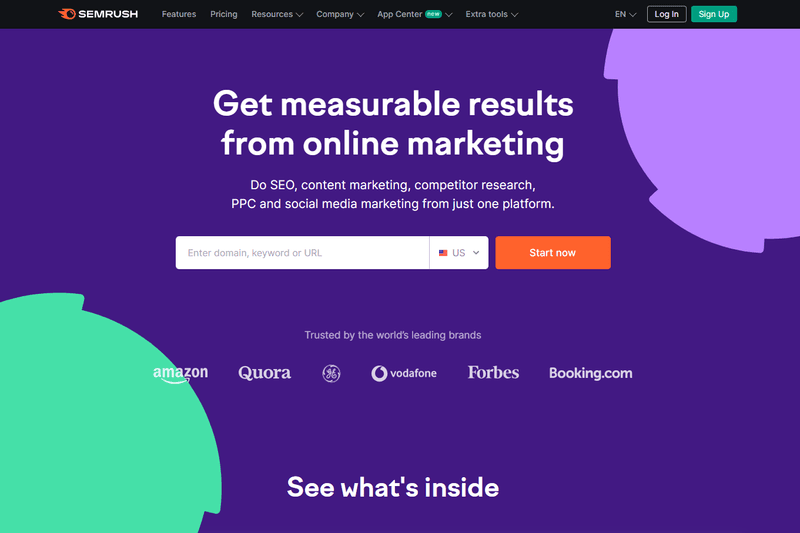
Semrush is a comprehensive suite of SEO tools designed to boost your keyword research, competitor analysis, backlink analysis, and SERP analysis efforts. With Semrush, you can revolutionize your SEO strategy and take your website’s performance to new heights.
Semrush offers a wide range of features that can help you optimize your website for search engine visibility. Whether you’re a beginner just starting with SEO or an experienced marketer looking to gain a competitive edge, Semrush has got you covered.
Keyword Research
One of the key areas where Semrush excels is keyword research. By analyzing search trends and competition, Semrush provides valuable insights that can guide your content strategy and help you uncover untapped keyword opportunities. You can discover new keywords to target, analyze their search volume and competition, and track their performance over time.
Competitor Analysis
Competitor analysis is crucial in understanding what works in your industry and identifying gaps in your own strategy. With Semrush’s competitor analysis features, you can uncover your competitors’ top keywords, analyze their backlink profiles, and gain valuable insights into their SEO strategies. This information can help you develop targeted campaigns and outperform your competition.
Backlink Analysis
Backlinks are a vital component of any SEO strategy. Semrush’s backlink analysis tools allow you to explore your website’s backlink profile, identify high-quality opportunities, and optimize your link-building efforts. By understanding which websites are linking to your competitors, you can build a strong backlink profile that boosts your website’s authority and visibility.
SERP Analysis
Understanding search engine result pages (SERPs) is crucial for optimizing your website’s visibility. Semrush’s SERP analysis features enable you to analyze organic and paid search results, identify featured snippets and other SERP features, and uncover user intent. By gaining a deeper understanding of SERPs, you can optimize your content and SEO strategy to rank higher in search engine results.
Step-by-Step Guide to Using Semrush for Keyword Research
Sign up for a Semrush account
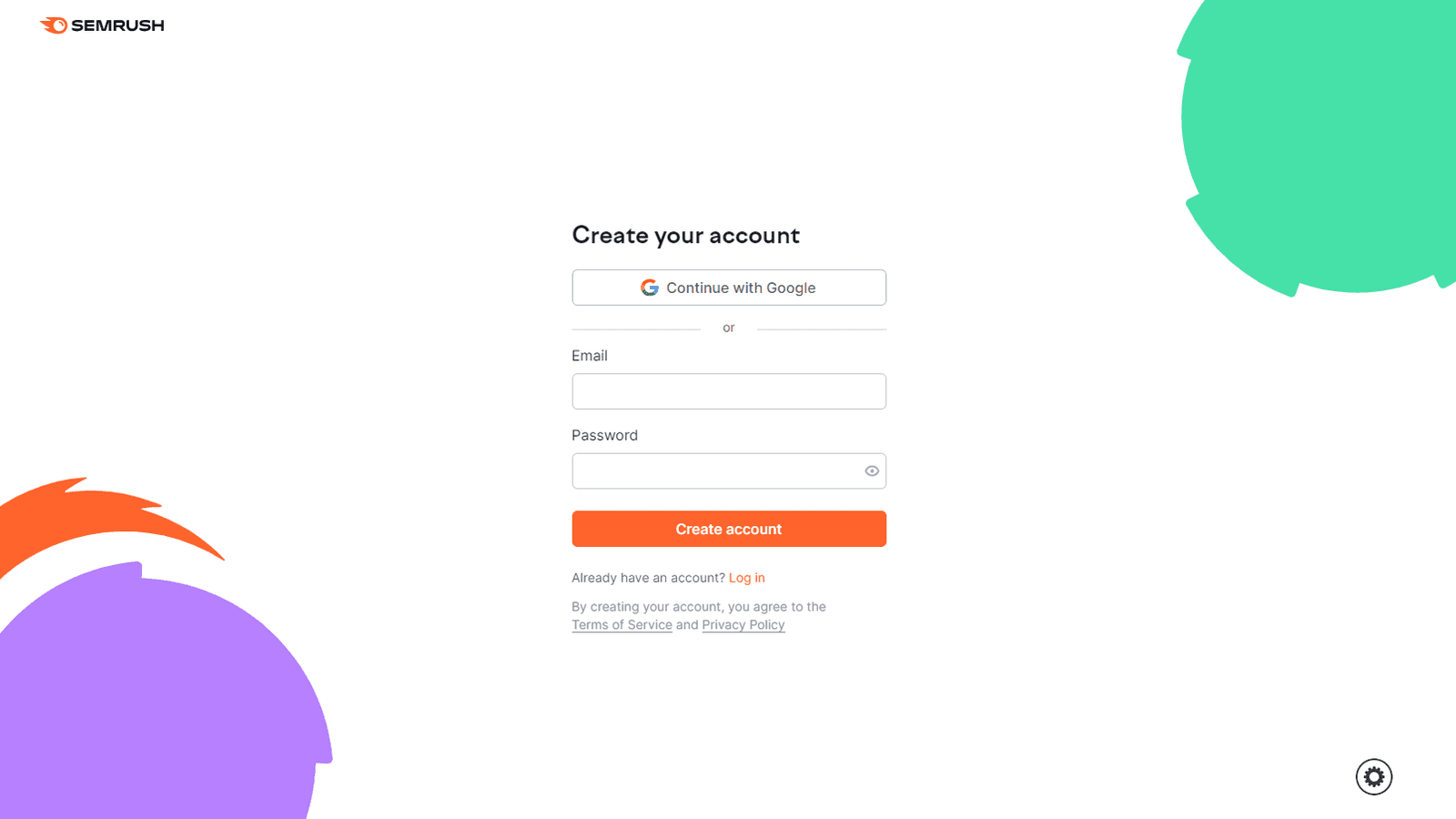
To get started, you’ll need to create a free Semrush account. Once you’ve signed up and logged in, you’ll have access to their keyword research tool.
Enter your seed keywords
Enter a few seed keywords related to your topic into the Semrush keyword research tool. These should be broad terms that represent your overall content theme. Semrush will then generate hundreds of related keywords and key phrases.
Filter and refine
You’ll likely end up with way more keywords than you need, so filter them down. You can filter by search volume, keyword difficulty, length, and more. Look for mid-tail keywords with decent search volume and low-medium difficulty. These will be easier to rank for.
Analyze keyword metrics
For your top keyword candidates, analyze the metrics to determine the best options. Look at search volume, keyword difficulty, trend, and CPC. Search volume indicates potential traffic. Difficulty and CPC show how competitive it will be to rank. Trend tells you if interest in the keyword is rising or falling.
Explore the data
Don’t just look at the metrics, actually research the keywords themselves. Search the terms on Google and see what’s currently ranking. Check out the page titles, URLs, and content of the top 10 results. See if you can create content that’s more comprehensive or higher quality. The more you understand your keywords, the better content you can create.
Track your rankings
Once you’ve optimized your content for your target keywords, use Semrush to track your rankings and performance over time. Enter the URLs of your content and Semrush will show you how you rank for your keywords in the search engines. This helps ensure your optimization efforts are effective and allows you to make tweaks to continue improving.
With the right keyword research, you’ll be creating high-quality content that ranks well in search and drives relevant organic traffic to your website. By following these steps, you’ll be mastering keyword research with Semrush in no time!
Performing Keyword Gap Analysis With Semrush
Semrush is a powerful tool for analyzing how well your website ranks for important keywords compared to your competitors. This is known as a keyword gap analysis and it can uncover opportunities to improve your content and SEO strategy.
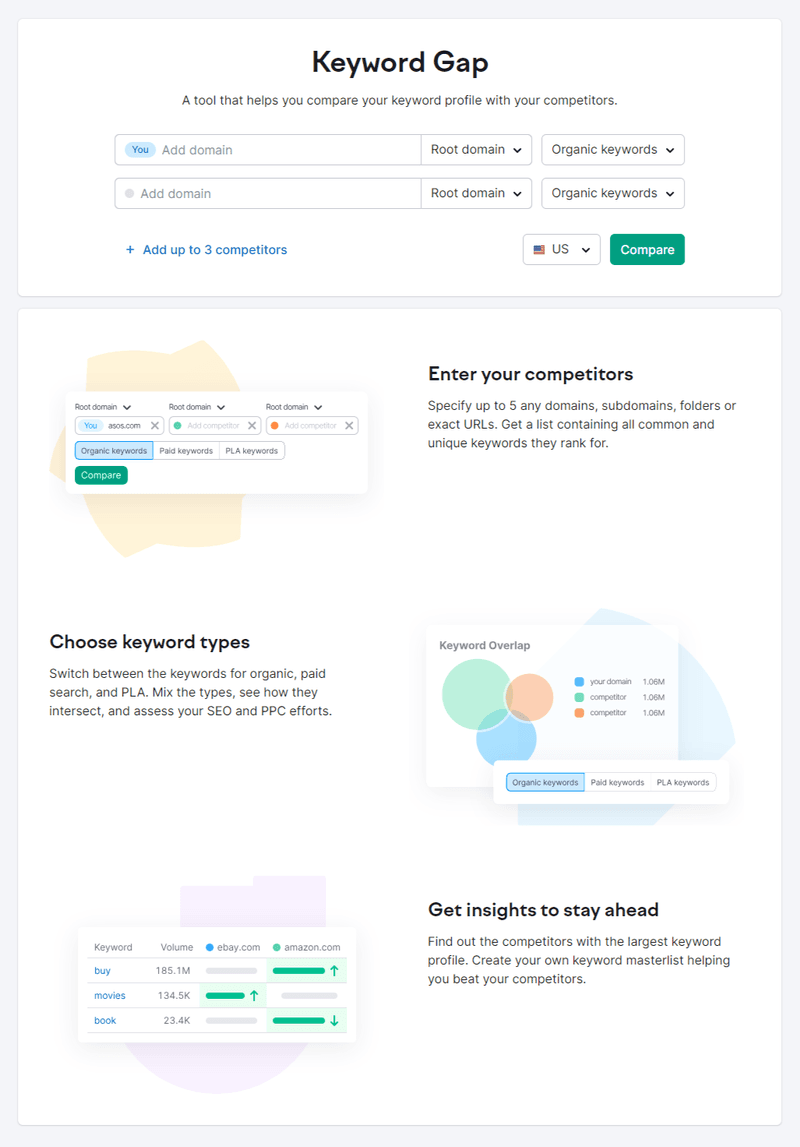
Check Your Ranking Positions
First, enter a list of keywords you want to track into Semrush. These should be terms that are relevant to your business and that you want to rank well for in search results. Semrush will show you how your website currently ranks for those keywords, as well as your competitors’ rankings.
Identify Gaps
Look for keywords where your competitors outrank you, especially if they’re ranking in the top 10 results. These represent gaps in your content and SEO that you need to fix.
For example, if “content marketing strategy” is an important keyword for your business but you’re not even on page 1 of results, you should make optimizing for that term a priority.
See What’s Working for Competitors
Check what pages on your competitors’ sites are ranking well for your target keywords. See what content they have, and how they’ve optimized the page, and look for opportunities to create similar or better content on your own site. You might find new topics or angles to cover that your audience would find valuable.
Improve Your Content
Based on what you find in the gap analysis, you can make a plan to improve your content and SEO. This may include creating new blog posts or web pages targeting high-priority keywords, optimizing existing content by adding keywords and internal links, earning more high-quality backlinks, and technical fixes like improving page load speed or fixing 404 errors.
Repeating this process regularly will help ensure you stay ahead of competitors and continue to close important keyword gaps. With time and continuous optimization, you’ll start ranking higher and higher for the keywords that matter most for your business.
Semrush provides an easy way to keep tabs on how you’re improving and uncover new opportunities to build a strong content and SEO strategy.
Finding Low Competition Keywords Using Semrush Tools
Semrush offers several tools to help you find keywords with low competition, so you can rank quickly in Google and drive more traffic.
Keyword Magic Tool
This tool analyzes millions of keywords to find hidden opportunities with high search volume but low difficulty. It provides keyword ideas along with their search volume, CPC, and difficulty score so you can evaluate which ones match your content goals. Look for keywords with a difficulty of 0 to 30 for the best chance to rank.
Keyword Gap
The Keyword Gap tool finds popular keywords that your competitors rank for but you don’t. This reveals gaps in your content strategy so you can create pages targeting those terms. Focus on keywords with high search volume and difficulty you can realistically rank for.
Related Keywords
For any keyword, the SEO Content Template tool provides a list of semantically similar terms. These are great for using in your content to improve search visibility. They also suggest new keyword opportunities, especially if the related terms have decent search volume but your competitors haven’t targeted them yet.
Using these Semrush tools together, you’ll discover a treasure trove of low-competition keywords that you can strategically target to earn higher rankings, increase organic traffic, and ultimately gain more customers.
The key is to start with keywords you have a good chance of ranking for, then build up from there as your domain authority improves over time. With regular use of Semrush, you’ll gain valuable insights into your niche and find the best keywords to focus your content creation efforts on.
Analyzing Keyword Intent in Semrush
Semrush allows you to analyze the intent behind keywords to determine the best ones to target. When you enter a keyword into the Semrush Keyword Magic Tool, you’ll see the intent categorized as informational, commercial, transactional, or navigational.
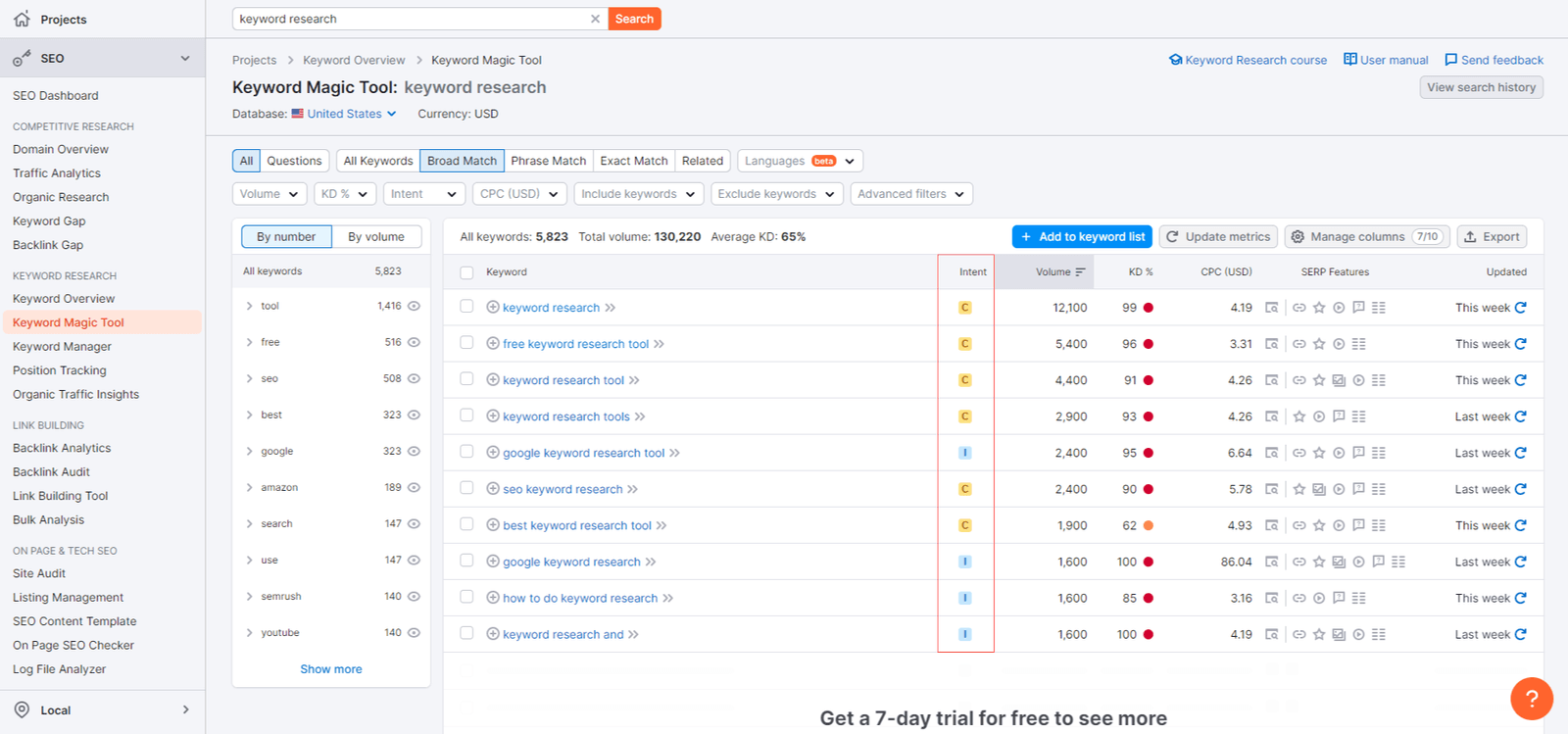
Here’s how you can analyze keyword intent using Semrush:
- Enter a keyword in the Semrush search bar.
- Click on the “Keyword Overview” tab in the left sidebar.
- Scroll down to the “SERP Features” section.
- Semrush will display the different types of search results for that keyword, such as featured snippets, knowledge graphs, and more.
- By analyzing the SERP features, you can determine the intent behind the keyword and create content that meets the user’s needs.
Informational Keywords
Informational keywords indicate the searcher is looking to learn or research something. For example, “history of social media” or “how do solar panels work?” These keywords are ideal if you want to rank for educational content. As a content writer, focus on in-depth, well-researched content to rank for informational keywords.
Commercial Keywords
Commercial keywords signal the searcher has the intent to buy a product or service. Keywords like “best laptop for students” or “top 10 web hosting” are commercial. If you want to rank for these, provide reviews, recommendations, and affiliate links to products. As a marketer, target commercial keywords to drive sales and conversions.
Transactional Keywords
Transactional keywords indicate the searcher wants to complete an action like make a purchase, sign up, or download something. Examples are “buy movie tickets online” or “create a website.” Optimize pages for transactional keywords by making the desired action very easy to complete. Provide clear calls-to-action like “Start your free trial today!” or “Buy now for $29.99”.
Navigational Keywords
Navigational keywords are when the searcher is looking to visit a specific website or webpage. The keyword will often be a brand name, product name, or URL. For example, “semrush” or “rankesper.com”.
To rank for navigational keywords, focus on building authority and optimizing your on-page SEO. Provide useful content and a great user experience to keep people engaged on your site.
By determining keyword intent in Semrush, you can develop a targeted content and link-building strategy. Focus your efforts on the keywords that match your goals, whether that’s driving traffic, conversions, or brand awareness. And optimize your pages and content for each intent to give searchers exactly what they’re looking for.
Tracking Keyword Rankings in Semrush
Once you’ve identified valuable keywords for your site, you’ll want to keep tabs on how they rank in Semrush. Tracking rankings lets you see how your optimization efforts are impacting visibility and traffic.
Here’s how you can track keyword rankings using Semrush:
- Navigate to the “Position Tracking” tool in Semrush.
- Click on “Create a New Project” and enter your domain and target keywords.
- Select the desired location and device type for tracking.
- Semrush will start tracking your keyword rankings and provide regular updates on their positions.
- Use this data to identify keywords that need improvement and optimize your content accordingly.
Check Keyword Positions
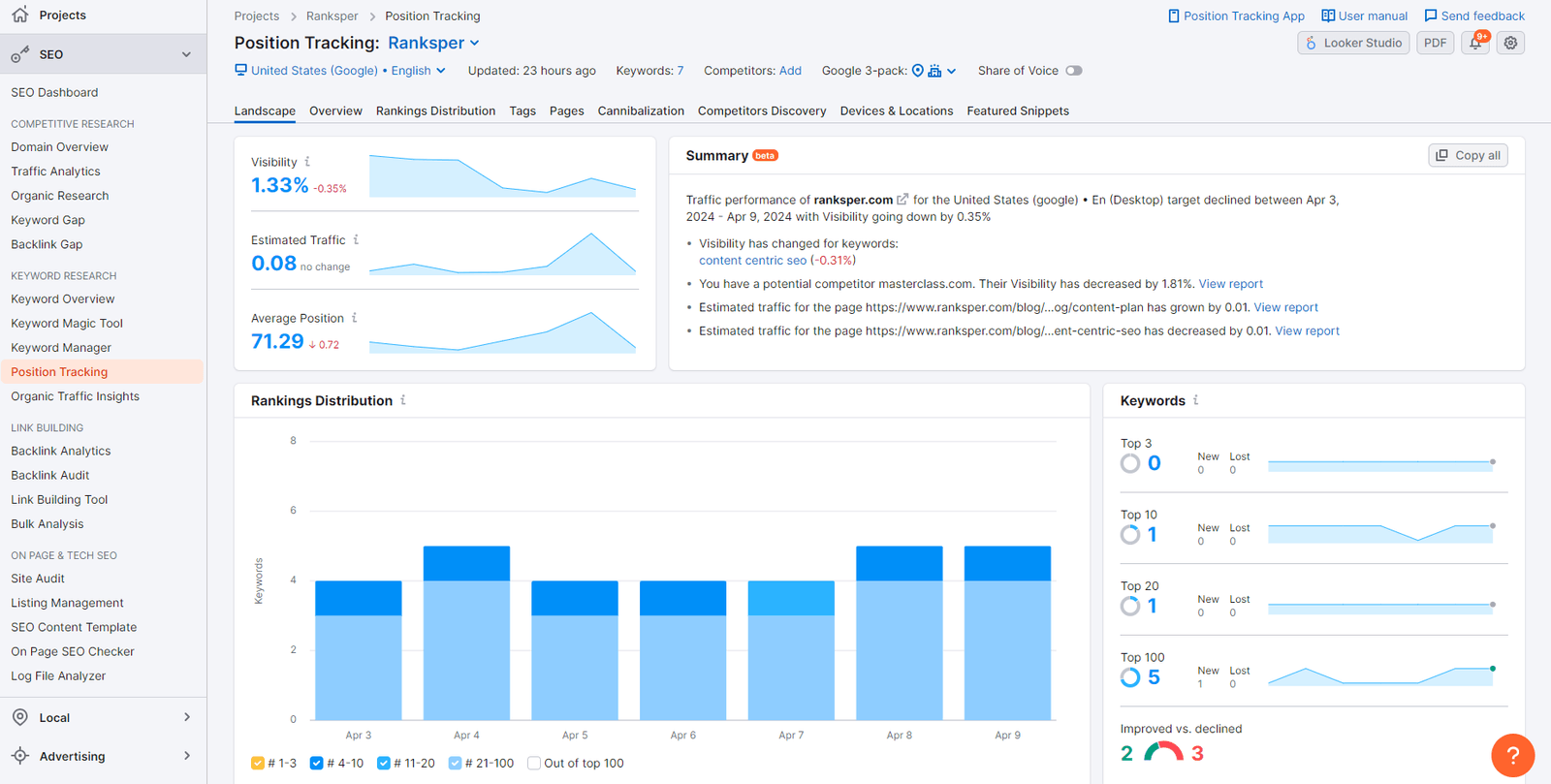
To view your keyword positions, go to the Position Tracking tool. Here you’ll see a list of the keywords you’ve added, along with their current position for your site. A higher position means better visibility in search results.
Check your rankings regularly, especially after making changes to your site like publishing new content, updating meta titles and descriptions, or building internal links. See how these efforts impact your keyword positions over the next few weeks and months. Even small ranking increases can lead to big traffic gains.
Compare Rankings to Competitors
In the Position Tracking tool, you can also compare your keyword rankings to competitors. Select the competitors you want to compare, and you’ll see side-by-side position data for your chosen keywords. Look for positions where you outrank competitors, as well as keywords where competitors outrank you. The latter provides opportunities to improve your content and SEO to gain better positioning.
Track Ranking Fluctuations
Keyword rankings are not static. They can fluctuate for many reasons, such as changes Google makes to its algorithm, new content published, seasonal trends, and more. Use the Position Tracking tool to monitor how your keyword positions change over time. Look for overall upward trends, as well as declines that could signal issues you need to address.
Tracking keyword rankings in Semrush is key to measuring the success of your SEO and content strategies. Review your keyword positions regularly, compare to competitors, and monitor fluctuations over the long term.
With this data, you can make informed decisions about how to strengthen your SEO and move up in the search results. Focus your efforts on improving for keywords that matter most for your business.
Using Semrush Keyword Magic Tool for Content Ideas

The Keyword Magic Tool in Semrush is a goldmine for generating content ideas. This tool provides related keywords, questions, and topics based on a seed keyword.
Related Keywords
Type in broad keywords like “content writing” and you’ll get a list of semantically similar keywords and phrases. These can generate ideas for blog posts, videos or other content. For example, “content writing” might return “blog writing,” “copywriting,” “content marketing,” and “content creation.”
Questions & Answers
The Questions section shows common questions people search related to your seed keyword. These questions make perfect topics for blog posts, videos, or other content. For “content writing,” some questions might be:
- How do I become a freelance content writer?
- What skills do you need to be a content writer?
- How much do content writers make?
You can easily turn these into content ideas like “How to Become a Freelance Content Writer: The Ultimate Guide” or “Content Writer Salaries: How Much Do Content Writers Really Make?”
Topic Clusters
The Topic Clusters provide groupings of related subtopics. For example, under “content writing” you may see topic clusters like:
- Types of content writing (blog posts, social media, email newsletters, etc.)
- Content writing tools and software
- Content writing skills and techniques
- Content writing jobs and careers
Each of these clusters contains many individual subtopics that can be turned into content ideas. The Topic Clusters give you a bird’s-eye view of all the potential content you could create around a broad topic.
Semrush’s Keyword Magic Tool takes the guesswork out of coming up with content ideas. With just a single seed keyword, you’ll have more ideas than you know what to do with! Take your time exploring all the options to find content ideas that excite and inspire you. Your readers will appreciate the value of the content you create.
Integrating Semrush With Other Tools
Once you’ve mastered using Semrush for keyword research on its own, it’s time to take things to the next level by connecting it with other digital marketing tools in your arsenal. Integrating Semrush with tools you already use can help streamline your workflows and provide an even more powerful analysis of your site’s SEO.
A few of the top tools that integrate seamlessly with Semrush are:
Google Analytics
If you want to see how people are finding and interacting with your content, connecting Semrush and Google Analytics is a must. By linking your Google Analytics account, you can view metrics like click-through rates, time on page, and bounce rates for keywords you’re targeting. This helps determine which keywords are the most valuable in terms of on-page engagement and conversion.
Google Search Console
Linking Semrush to Google Search Console allows you to see how Google actually ranks your pages for target keywords. You can view metrics like average position, total impressions, and click-through rate over time. This data helps identify opportunities to improve your rankings for important keywords.
Google Ads
For pay-per-click marketers, the Google Ads integration provides useful insight into how your ad campaigns are performing for specific keywords. You can see metrics such as cost-per-click, conversions, and return on investment for keywords you’re bidding on. This helps optimize your PPC campaigns by focusing budgets on the keywords that provide the best results.
Other tools like Moz, Ahrefs, and Google Optimize also offer powerful integrations with Semrush.
Connecting the tools you use, and taking advantage of the data they provide together, is key to developing an effective SEO and content strategy. The insights you gain can help increase organic traffic, improve on-page engagement, and boost ROI over the long run.
Overall, Semrush integrations turn good keyword research into great keyword research.
Conclusion
So there you have it – the complete guide to mastering keyword research with Semrush. Now you’re armed with all the info you need to choose the best keywords, find keyword gaps, group keywords, analyze the competition, and track your rankings over time.
With the power of Semrush behind you, you’ll be able to create high-performing content that drives organic growth. Just remember to stay focused on relevancy and intent, not just volume. Keep those keywords precise and targeted.
And don’t get overwhelmed by all the data – start small and work your way up as you get familiar with the platform. The opportunities are endless if you use Semrush strategically.
So get out there, do your keyword research, and start dominating those SERPs!
FAQs About Semrush
Semrush offers a ton of keyword metrics. Which ones should I focus on?
For keyword research, concentrate on volume, difficulty, and trend. Volume shows how many monthly searches a keyword gets, so you can find opportunities with high traffic potential. Difficulty, like Keyword Difficulty Score, tells you how hard it will be to rank for a keyword so you can set realistic targets. And trend shows if interest in a keyword is rising or falling over time.
How many keywords should I target?
There’s no set number, but in general aim for 1 to 2 well-researched primary keywords, and 2 to 5 secondary keywords for each of those. Primary keywords should get at least 1,000 searches per month and have a difficulty you can reasonably rank for. Secondary keywords get less traffic but are more specific, so they’re easier to rank for and help boost your primary keywords.
Should I do broad or long-tail keyword research?
Focus on a mix of both. Broad keywords like “content writing tips” get more traffic but are harder to rank for. Long-tail keywords such as “tips for beginner content writers” get less traffic but are easier to rank for. So do research on broad keywords to find opportunities, then look at long-tail variants to find keywords that match your abilities. You can also start by ranking for long-tail KWs, then optimize to rank better for the broader terms over time.
How often should I do keyword research?
It’s a good idea to refresh your keyword research every 3 to 6 months. Search trends change, new keywords emerge, and the difficulty of existing keywords shifts over time. Regular research ensures you’re always optimizing your content for the best opportunities. You don’t need to start from scratch each time, but check on the metrics for your target keywords and look for any new keywords worth pursuing.
Does Semrush provide data for local keyword research?
Yes, Semrush offers data for local keyword research. You can specify a specific location and get insights into the search volume, competition, and trends for keywords in that particular area. This is particularly useful for businesses that target a specific geographic location and want to optimize their website for local search.
How can I use Semrush for competitor analysis?
Semrush is an excellent tool for competitor analysis. It allows you to enter your competitor’s domain name and get detailed information about their organic and paid search strategies, top keywords, backlinks, and more. By analyzing your competitors’ strategies, you can gain valuable insights and identify opportunities to improve your own digital marketing efforts.






Comments
This is very interesting, You’re a very skilled blogger. I’ve joined your feed and look forward to looking for extra of your great post. Additionally, I have shared your web site in my social networks!
Hi, thank you very much. As a founder of a new brand, this means a lot to me. Me and my team are trying our best to provide real value to the user. And currently we are working on updating some of our existing content to make it even better. Will definitely come up with more valuable and engaging content in the near future.